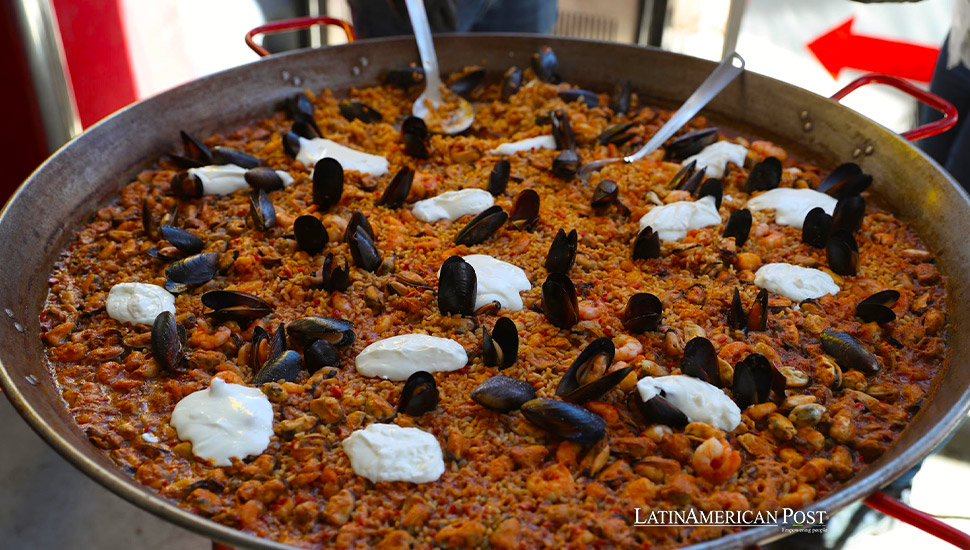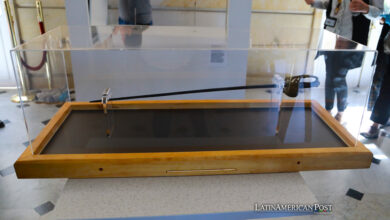Paella and Rice: A Culinary Bridge Between Peru and Spain

Peru and Spain celebrated their shared culinary heritage through a masterclass on paella led by Valencian chef Chabe Soler in Lima. The event highlighted the historical and cultural connections between the two countries, united by rice—a staple that transcends borders.
A Dish That Transcends Borders
In a grand celebration of culinary artistry, Peru and Spain came together on Friday to honor the deep historical and cultural ties that bind them, focusing on a beloved ingredient: rice. The event, organized with the support of the Spanish Embassy in Lima, featured a masterclass on paella, the iconic Spanish dish, led by Valencian chef Chabe Soler. But beyond the food, the gathering symbolized something much more significant—how gastronomy can unite nations through shared history and identity.
Ricardo García López, the cultural and scientific counselor of the Spanish Embassy in Peru, opened the event with a heartfelt reflection on what paella represents. “The key element of paella is diversity, mestizaje, identity, and unity,” he explained. “A paella can contain everything; it has room for all kinds of diversity, which Peru and Spain share, and we always see it as a strength.”
His words touched on more than just the culinary aspects of the dish; they highlighted a deep, centuries-old relationship between Spain and Peru, rooted in a shared love for food and the exchange of ingredients. As García López pointed out, rice made its way to Peru through Spanish influence during the colonial period, while potatoes, native to the Andes, traveled in the opposite direction, becoming a staple in European kitchens. These humble yet powerful ingredients symbolize the rich, intertwined history between the two countries.
The History of Paella: A Dish That Tells a Story
The origins of paella date back to the eastern coast of Spain, specifically Valencia, where the dish emerged as a humble meal prepared by farmers and laborers. Traditionally cooked in a large, shallow pan over an open flame, paella was made with whatever ingredients were available—often rabbit, chicken, vegetables, and rice. The word “paella” comes from the Old Valencian word for pan, emphasizing the central role of the cooking vessel in this dish’s identity.
Over time, paella evolved into one of Spain’s most cherished national dishes, with countless regional variations. Seafood paella, made with the bounty of Spain’s Mediterranean coast, is perhaps the most internationally recognized version, but the dish remains highly adaptable. Paella’s versatility speaks to its inclusivity—a theme echoed by Chef Soler during the masterclass. She noted, “A paella can incorporate many different ingredients, and this ability to adapt and transform is part of its magic. It reflects the diversity of cultures and flavors.”
Rice, the cornerstone of paella, was introduced to Spain by the Moors in the 8th century. The crop thrived in the marshy wetlands of Valencia, eventually becoming the key ingredient in Spain’s culinary traditions. From there, it spread across the Spanish Empire, arriving in the Americas and finding a home in Peruvian cuisine, where it remains central to the diet today.
A Culinary Exchange: Rice in Peruvian Cuisine
In Peru, rice holds a special place in the nation’s gastronomy, much like in Spain. After the Spanish brought rice to Peru in the 16th century, it quickly integrated into local diets, blending with indigenous ingredients to create new, distinctive dishes. Today, rice is a daily staple for many Peruvians, featured in iconic dishes such as arroz con pollo (rice with chicken) and arroz chaufa (Peruvian-Chinese fried rice), a nod to the country’s rich cultural diversity.
Peruvian cuisine, like Spain’s, reflects its complex history and the fusion of various cultural influences. The arrival of the Spanish in the 1500s brought new ingredients and cooking techniques that merged with the indigenous culinary traditions of the Andes. Later waves of immigrants from Africa, China, and Japan further enriched the Peruvian food landscape, creating a unique gastronomic identity now celebrated worldwide.
Chef Soler touched on this deep connection during the masterclass, stating, “This event is about more than just cooking rice; it’s about celebrating the shared history between Peru and Spain. It’s fascinating to see how rice, a universal ingredient, is prepared differently in both countries.”
Participants in the masterclass cooked and shared paella, allowing them to experience firsthand how one ingredient—rice—can serve as a bridge between cultures. The dish’s ability to unite people from different backgrounds makes it so beloved in Spain and worldwide.
Paella is a Symbol of Unity and Diversity
Paella, at its core, is a dish that embraces diversity. It is as much a symbol of Spain’s regional variety as it is a testament to the country’s history of cultural exchange. During her demonstration, Chef Soler emphasized this point, explaining that paella is “a dish with room for everything,” from seafood to meats, vegetables to legumes. “It’s a reflection of how Spain, much like Peru, has always been a melting pot of different cultures,” she said.
The Valencian chef also took the opportunity to dispel some of the myths surrounding paella. “Sometimes, you come across dishes that claim to be paella but are far from the real thing,” she joked, eliciting laughs from the audience. “My goal today is to show you what authentic paella is—made with love, care, and respect for tradition.”
Her demonstration focused on the traditional paella Valenciana, a version made with rabbit, chicken, and green beans, cooked to perfection with the signature socarrat, the crispy layer of rice that forms at the bottom of the pan. For Soler, this dish is more than just food—it represents her identity and the culinary heritage of her homeland. “Cooking paella is like telling a story,” she said. “It’s about sharing our culture, traditions, and way of life with the world.”
This idea of sharing culture through food resonates deeply in Spain and Peru, two countries known for their passion for gastronomy. As García López mentioned, “The relationship between Spain and Peru is rich in history, and food is a beautiful way to honor that history. It allows us to celebrate what we have in common while appreciating our differences.”
A Celebration of Gastronomy and Friendship
The event, held at the Universidad San Ignacio de Loyola in Lima, brought together food enthusiasts, students, and diplomats alike, all eager to learn the secrets of making a perfect paella. But beyond the cooking techniques and the delicious aromas that filled the air, the day celebrated the strong cultural ties between Spain and Peru—two nations whose love for food has always been a connection point.
As the class concluded, Chef Soler reflected on the day’s significance. “When two great gastronomic powers like Spain and Peru come together, only wonderful things can happen,” she said with a smile. Her words were a fitting conclusion to a day celebrating a dish and the enduring friendship between the two countries.
Also read: Bolivian Brandy Singani Captivates Connoisseurs and Hollywood
Indeed, Spain and Peru love gastronomy. Whether through the meticulous preparation of paella in Valencia or the vibrant flavors of Peruvian ceviche, both countries have long understood the power of food to bring people together. As Chef Soler aptly said, “When we cook with love and passion, we are not just making a meal—we are sharing a piece of ourselves.”





